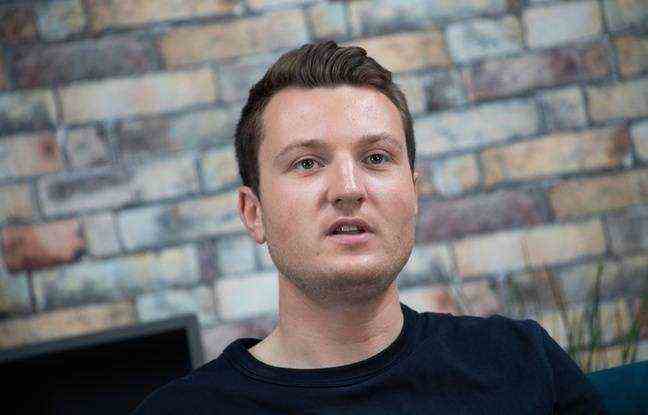Guillaume Rozier, the creator of CovidTracker and Vitemadose. – Olivier Juszczak / 20 Minutes
- Every week, 20 minutes offers a personality to comment on a social phenomenon in his meeting ” 20 minutes with… ”.
- This Friday, place Guillaume Rozier, who has become, at only 25 years old, the most famous data analyst in France. After launching CovidTracker, which makes it possible to follow the evolution of the epidemic in France, he developed, with other volunteers, Vitemadose, which helps to find a niche to be vaccinated.
- It is further improving this site by launching Chronodose this week, a site and an app allowing people over 18, still not having a priority, to “save a dose that would not have found a taker during the day or the next day”.
This Tuesday noon, he has just received his first dose of vaccine. Guillaume Rozier, 25, has become the reference data engineer on Covid-19. Because in March 2020, he launched CovidTracker, the popularization site on the epidemic that feeds government communications, the media and informs the general public. VaccinTracker, Vitemadose, and now Chronodose will follow … 20 minutes met this young engineer who lacks neither energy nor imagination.
How was CovidTracker born?
In March 2020, I was doing an end-of-studies internship in a bank in Luxembourg for six months. On March 5, I am making a comparison chart of the cases of Covid-19 in France and in Italy. What shocked me was the exponential growth of the curves and their superposition, 8 days late for France. I am sending this graphic to my relatives. Every day they would ask me to update it. After a while, I make a homemade web page. Unfortunately, the number of cases has skyrocketed. I started to make a real site, with two, three, four graphics …
Until CovidTracker became THE benchmark for monitoring the epidemic, with 10 million unique visitors in April 2021… Did you expect such success?
Really not at all. The first shock is when a large hospital calls me in September 2020 to tell me “thank you Guillaume, we use CovidTracker every day in the crisis cell”. The second electroshock is the invitation to Daily [sur TMC] at the end of the year. Until then, I said to myself: “I can’t be the one doing the most used site. There are going to be real web developers, companies, the State… ”
In January 2021, you launch VaccinTracker, then in April Vitemadose. The latter allows a priority person to easily find a niche on one of the five platforms to be vaccinated. Do you have an idea of the number of French people vaccinated thanks to this site?
Impossible to know. We do not allow the reservation of doses, we refer to the platforms of use. Doctolib has 30,000 appointments made per day that come from Vitemadose.
And your last baby is Chronodose …
Since Tuesday, those over 18 who do not have priority can reserve a time slot left vacant for the same day and the next day on Chronodose [un onglet à l’intérieur du site ou de l’appli Vitemadose]. We are talking about a few thousand to tens of thousands of niches. But it is not this measure that will allow young people to be vaccinated.
In early April, you asked for a helping hand on Twitter to improve Vitemadose’s algorithm. Is it a collective adventure?
Yes. On Tuesday, I had the idea, on Thursday, I had a craft site. The enthusiasm was important, but the quality of the site not extraordinary. On April 2, I tweeted asking the developers for a helping hand. About 110 people joined the Telegram chat. They did the three-eights for a week to make the algorithm compatible with all five platforms. And to go from 5 hours to 1 minute to scan slots throughout France.
Now, the novelty is that with the application, we can have two types of notifications. You can first subscribe to a particular center; if he adds a slot, we are notified. The other is for chronodoses.
Do these platforms have a cost, and if so, by whom is it insured?
All those who participate are volunteers. But there are technical costs. Companies give us discounts or loan servers. The rest is paid for. Users can do microdons. This allows us not to put out of our pocket.

You work full time as a data analyst. You invent an app every three months. You are all over the media. You tweet day and night… Do you sleep at night? Do you have a doppelganger?
I have dark circles… My company considers it a public utility project, so I have some flexibility. But I do Covidtracker at noon, in the evening, on weekends… I could not continue this rhythm of life for several years. If the epidemic does not stop, I will stop myself.
What do you remember from this adventure?
I realized that useful things could be done more easily than I imagined. I learned a lot about development, health management. I had never touched epidemiology! Catherine hill [épidémiologiste à l’Institut Gustave-Roussy de Villejuif] called me and did a class for two hours.
Is it up to student volunteers to offer a service (and a responsibility) of this size or to the state?
It’s a question I ask myself… And I don’t have the answer. The State has not done anything: there are Géodes, TousantiCovid… But above all, the data are published in an exhaustive manner every day. Some believe that this is the normal way open data works. The state is doing what only it can do: collect health data. He must be obliged to aggregate and publish them. On the other hand, citizens can use it to make innovative tools.
There is a boomerang return for public administrations: Inserm uses CovidTracker for its research, Castex and Macron for their conferences. Should the state have done better? I think yes. What would have happened if we hadn’t done CovidTracker? What is its influence on public debate? I have the impression that since it has grown a lot, there is less false information in the media. In the summer of 2020, while we saw in the figures that the epidemic was resuming in full in July, doctors said on television that there was no longer an epidemic. This is no longer the case today.

How do you work with the health authorities?
There is no collaboration. I have little communication with Public Health France and Olivier Véran. We are completely independent, we have no private or public funding. People realize that we are neutral. We do not want to be confined or deconfined, but to understand the reality of the figures.
Given the prevailing mistrust of vaccines, is it not profitable for citizens to publish these data?
I have the impression that this is the government’s argument: it is better for it to be independent. There is surely a grain of truth. We can see it clearly: TousAntiCovid is very much criticized. It amazed me that the first version caused endless debate, when the data is completely anonymized. Facebook goes much further in collecting personal data …
Regarding the mistrust vis-à-vis vaccines, I’m not worried The turnaround is happening: we have gained 20 points of confidence among young people in a month! From the moment you see three vaccinated friends who are doing well, that’s reassuring. Open data is an anti-conspiracy weapon, it allows transparency and verification. In March 2020, conspirators said there were no X cases of Covid-19. It was then necessary to trust Jérôme Salomon. There, we know what the cases are by department, by age and by sex.
How did you receive the tribute from Emmanuel Macron who tweeted on your site?
No slot should be lost.
From May 12, appointments that have not found a taker 24 hours before will be open to all adult volunteers, without condition.https: //t.co/H6mJCiN6iG– Emmanuel Macron (@EmmanuelMacron) May 6, 2021
He also sent us a message, it honors us that he salutes our work. But I didn’t do that to get the Legion of Honor. What we would like is a barbecue at the Elysée (smile) with the contributors of Vitemadose, but also other initiatives such as Covidliste.
Can your success change the outlook on social networks, often shown as an outlet or a place to exchange fakenews?
Perhaps. For me, it’s super positive. I am developers, epidemiologists. That’s how I found my job, that we helped tens of thousands of people find a dose, understand the epidemic, right down to the president.
Afterwards, it is true that conspiracy and violence, I see them more and more. Because Macron and Castex watch CovidTracker, for some political decisions, it would be my fault. Vitemadose unintentionally campaigns for vaccination. But I get 99% support, and that’s what keeps us motivated after a year.

You tweeted on Tuesday that the Vitemadose site was targeted by antivaccines …
In the heat of the moment, I didn’t think about registering and purchasing the Vitemadose domain name. On April 8, it was discovered that Vitemadose.fr and Vitemadose.com had been purchased. But the sites link to ours. A few days later, they put it up for sale between 5,000 and 10,000 euros. We refused. Until then, it was not malicious. But since Tuesday, there is anti-vaccine information on the site. That’s why I tweeted to say “beware, the right link is …” A pro bono lawyer is taking steps, we are going to dispute. So we should a priori recover the name.
Is the field of data under-invested in France compared to other countries?
Surely. We can imagine a lot of things with open data in health, but also in other areas: transport, ecological transition … The Digital Republic law of 2016 has changed the paradigm. Before, we did not publish the data, with some exceptions. Now the norm is publication, except for what poses a problem in terms of privacy.
You can’t imagine the value of data before you publish it. An isolated dataset, we can say that it is useless. But put in correspondence with another, it makes perfect sense. For example, by crossing the number of beds in sheaves and the number of people hospitalized in sheaves, we see the saturation of these services.

